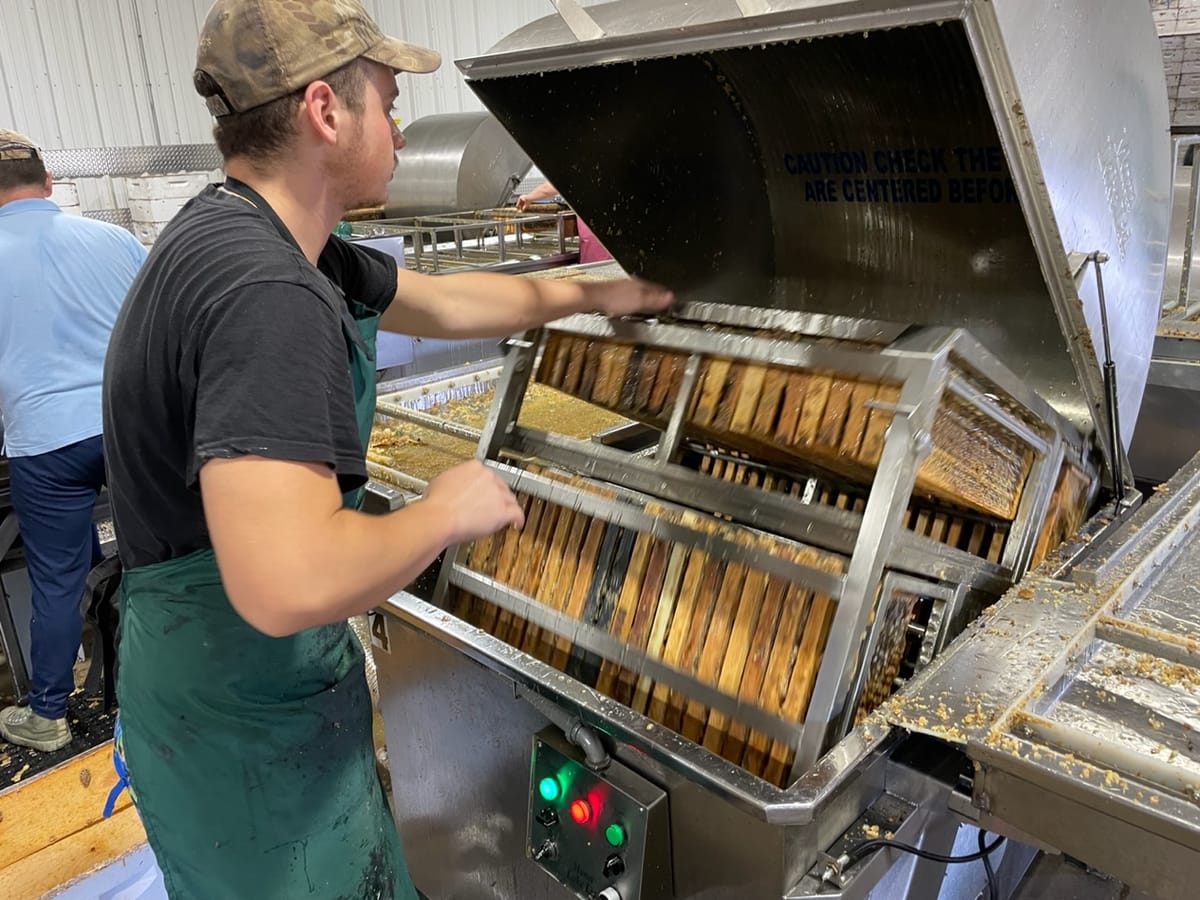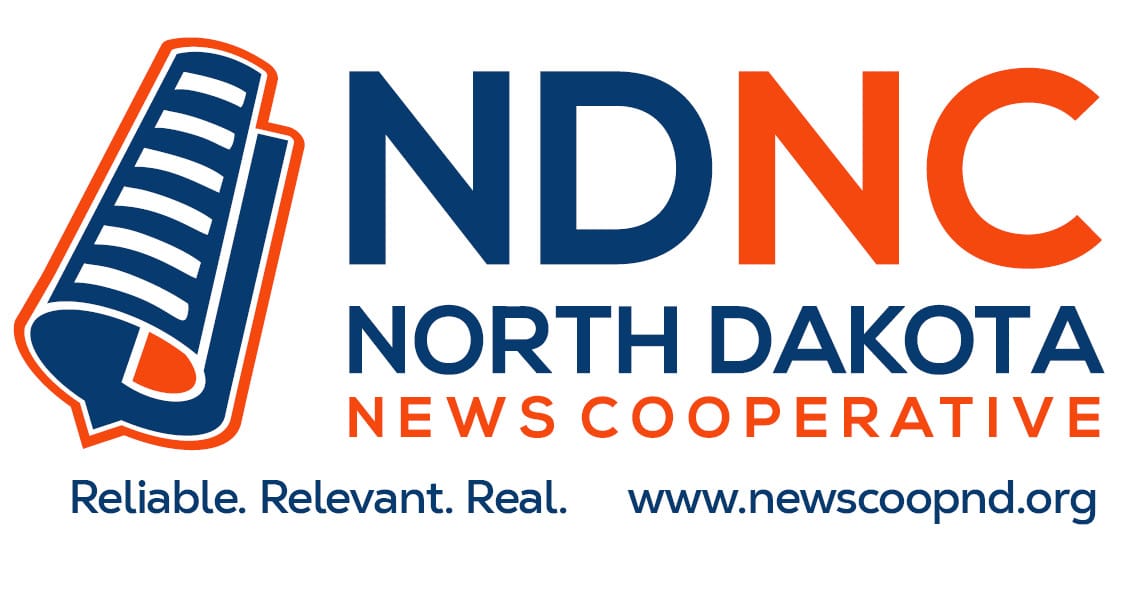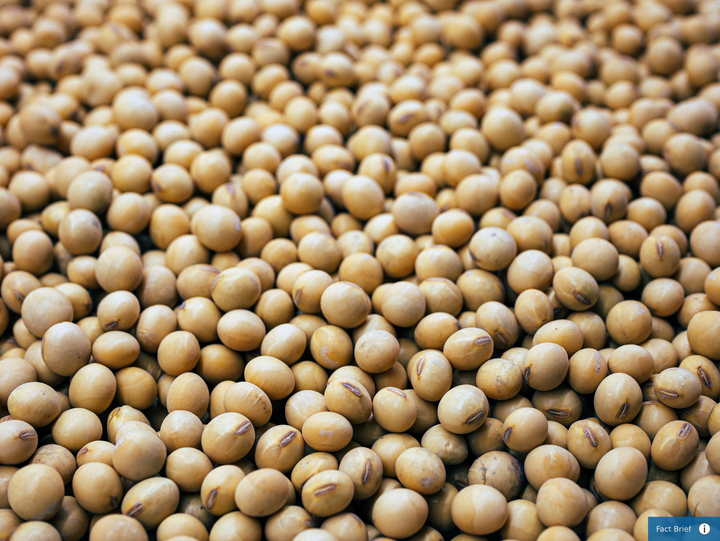Land use changed impacted honey bee health
Small steps pave way for pollinator paradise in North Dakota

JAMESTOWN, N.D. – As a 4th generation beekeeper and honey producer, Zac Browning knows his bees.
“Look here, this is a different type of native bee, this little hairy guy here,” Browning said, his voice a pitch higher than normal as he moves toward a burst of flowers.
In another section of pollinator habitat that has been restored near his honey production facility north of Jamestown, a small cloud of honeybees actively buzz. Just days before the plot was alive with Monarch butterflies prepping for their great migration south to Mexico.
Browning also knows what these pollinators eat. He points out remnants of alfalfa, giant red clover, native sow thistle, pods of common milkweed, white fanning fleabane, and stalks of Maximillian sunflower stretching above the other forage.
“Okay, look here, this is another native bee,” Browning says, moving to a grouping of bright yellow coreopsis.
The reason he is so interested is that this type of landscape has dramatically declined in the northern plains over the past two decades and it is starting to impact honeybees. An organization he helped launch seven years ago, the Bee and Butterfly Habitat Fund, where he now serves as board chairman, is trying to halt that decline before it is too late.
They would like to see 1,000 more sites like the one above to support bee populations and aim to enlist public and private landowners to set aside two-to-four acres or more to expand quality bee habitat in North Dakota.
Land changes impact pollinators
Browning’s family operation started in Idaho in the 1920s. In 2005, most production was moved to the current location near Jamestown, due to wide scale changes in land use in Browning’s home state. Those land use changes also began to occur in North Dakota almost as soon as his family arrived.
“In the early 2000s when we started keeping bees here, the predominate crop was wheat, and barley and sunflowers, and alfalfa and canola,” Browning said. “There was corn for sileage, but not fields and fields of production corn. Where there were cattle operations, there was corn for sileage. There were no soybeans.”
Then came the acre upon acre of corn and soybeans. What this did, he said, was pressure the Conservation Reserve Program (CRP) land as farmers converted over to those crops. That CRP land provided varied forage for bees as well as critical nesting and fawning ground for a variety of wildlife species.
From a high of 3.4 million acres in 2008, total CRP land in the state now stands around 1.1 million acres, according to the USDA Farm Service.
Prairie ecosystems that exist on CRP lands are also key to pollinator health, as well as to the health of both native and honeybees, because a varied diet of a wide range of native and non-native flowers increases bee health and honey production.
North Dakota’s native prairie has also decreased by at least 72 percent since the first settlers arrived, impacting more native pollinators. Less than one-tenth of one percent of native tallgrass prairie exists in the state, almost exclusively located in the Sheyenne National Grassland, according to the U.S. Forest Service.
North Dakota is the top honey producing state in the country and has been for nearly two decades despite that loss of habitat, but that could change, particularly as bee health decreases.
“This is ground zero for the nation’s honeybees,” said Clint Otto, an ecologist at the USGS Northern Prairie Wildlife Research Center, just southeast of Jamestown.
Otto mainly researches native bees and other pollinators, but there’s a huge amount of crossover since they all need a variety of floral food sources that healthy habitats can provide.
Otto estimates at least 300 different native bee species exist in North Dakota, but only around 50 species have been identified.
“This is a really important part of the country for all things pollinators, both if you are talking about the ecosystem services they provide us humans and our growing human diet, and then just functioning ecosystems and the plants they pollinate,” Otto said. “That’s the foundation of our food web.”
Bee health declining
According to an annual survey released in June from Bee Informed Partnership, a group that surveys beekeepers to keep track of colony health across the country, 48 percent of honeybee colonies were lost in the year prior to April 1, 2023. This was the second highest death rate on record after similar losses in 2019.
Parasites like the varroa mite are a key culprit, as are other contributors like pesticides, extreme climatic events like heat waves and cold snaps, and even starvation.
Browning said bee health is directly tied to their food sources, which have diminished by as much as 80 percent in some places.
What’s left is often a mono-floral diet, where bees only have one or a small number of kinds of flowers to feed upon. Imagine just eating a diet of only one kind of cereal, for every meal, all the time, Browning said.
“They’re less vigorous, less able to overcome disease. They’re weak, they’re sick, their population is diminished, they’re malnourished,” he said. “And so they succumb to viruses and pathogens and heat stress and cold stress and everything else that otherwise they would ward off with a healthy body. It's happening to honeybees. It's happening to the native bees.”
Heather Broccard-Bell, a honeybee health researcher at NOD Apiary Products in Trenton, Ontario, who follows bee health in the region, is working on a study funded by the North Dakota Department of Agriculture investigating the varroa mite and the viruses they carry.
The hope is eventually getting to a point where the viral impact from varroa mites could be treated before they decimate colonies and also prevent viral spillover to native species of pollinators. She also sees land use impacts to honeybee colonies.
“If you have honeybees that are surrounded by monoculture agriculture, then we do see an impact of the loss of variability in their diet,” Broccard-Bell said. “If habitat restoration is aimed at diversifying the flora and fauna of an area, that’s probably going to positively impact honeybees.”
Four acres at a time
After establishing 30 acres devoted to forage for pollinators using a mixture of flowers developed by the Bee and Butterfly Habitat Fund (B&BHF), Browning has seen them rush back in. Around 30 species of pollinators have been found on just a few acres here.
It’s an all-you-can-eat buffet for honeybees, native bees and other species like the migratory Monarch butterfly – now listed as an endangered species by the International Union for the Conservation of Nature -- and likely soon-to-be classified as endangered by the U.S. Fish and Wildlife Service.
Monarch numbers have declined by 80 percent in the past two decades largely because of the reduction of varieties of milkweed needed for larvae growth, as well as impacts from pesticides and herbicides, along with a reduction in floral food sources.
Currently B&BHF has 50 projects in North Dakota, 67 in Minnesota, and 62 in South Dakota.
Here’s how it works:
Landowners, land managers, municipalities and other entities interested can apply to have as little as two acres – though the fund prefers to start with four-acre projects – seeded with flower mixtures that attract pollinators. The planting is free, or at a reduced cost for larger projects, though landowners do need to prep a site. The preferred method is planting soybeans that fix nitrogen and lay a good groundwork for these mixes to flourish.
After a four-acre site is selected and prepped, two acres are planted with a honeybee seed mixture and two acres planted with a Monarch butterfly seed mix.
Both mixtures also have flowers attractive to native bees. Mixes also vary by state with North Dakota’s honeybee mix including 14 different wildflowers and the Monarch mix 48 different wildflowers. Both include a small amount of grasses as well.
Elsa Gallagher, habitat program director at the fund, points to research conducted by Otto that found eight times the number of native bees in acres using the Monarch mix compared to other conservation land.
“The main goal for our planting mix is to provide high quality pollinator habitat,” Gallagher said. “We don’t include a lot of grasses, we include things that the pollinators really like and that provide a lot of nutritional value.”
Room to expand
The current number of 50 projects is just a small amount of what’s truly needed in North Dakota, said Browning.
“I think if we can get to a critical mass, which might be 1,000 projects, it will just explode,” he said. “We think we need to get 1,000 landowners to enroll. We think that once that happens, then the conversation will be in every coffee shop.”
John Miller, who owns Miller Honey Farms near Gackle, and who is also a board member of B&BHF, sees the potential for growth as more landowners become aware of the benefits of establishing pollinator habitat on their lands.
“I want to believe as the pendulum swings to and fro, we might one day see more enlightened approaches to the three or so acres that can’t be farmed – too close to the slough, or in an awkward piece of the property, or it’s a shelter belt that’s come out – just some bread crumbs,” Miller said.
“Leave a few scraps out there for the butterfly,” Miller said. “Leave a few scraps out there for the bees.”
Miller sees a natural fit with sites on cattle ranches, as “bees and cattle have been getting along for a very, very long time.”
Browning also said the group has engineered a couple of pasture mixes that aren’t just good for bees, but also provide grass-high forbs and clovers “that can really benefit cattle in terms of augmenting their protein.”
Besides rural landowners, Bee and Butterfly has partnered with towns and municipalities on projects as well. Think unused plots of land around water treatment facilities, brownfield sites like old strip mines or former industrial sites. Corporate sites are another good space for habitat acres, they say.
Otto thinks the next frontier for reestablishing pollinator habitat that has been underutilized in North Dakota is urban areas in cities, villages and townships.
“It’s not by coincidence that you see in these urban areas where people are planting these flowers in the yard that these endangered species are hanging on and actually thriving in those areas,” Otto said. “In North Dakota, we could do a lot more of that.”
The North Dakota News Cooperative is a nonprofit news organization providing reliable and independent reporting on issues and events that impact the lives of North Dakotans. The organization increases the public’s access to quality journalism and advances news literacy across the state. For more information about NDNC or to make a charitable contribution, please visit newscoopnd.org. Send comments, suggestions or tips to michael@newscoopnd.org. Follow us on Twitter: https://twitter.com/NDNewsCoop.



